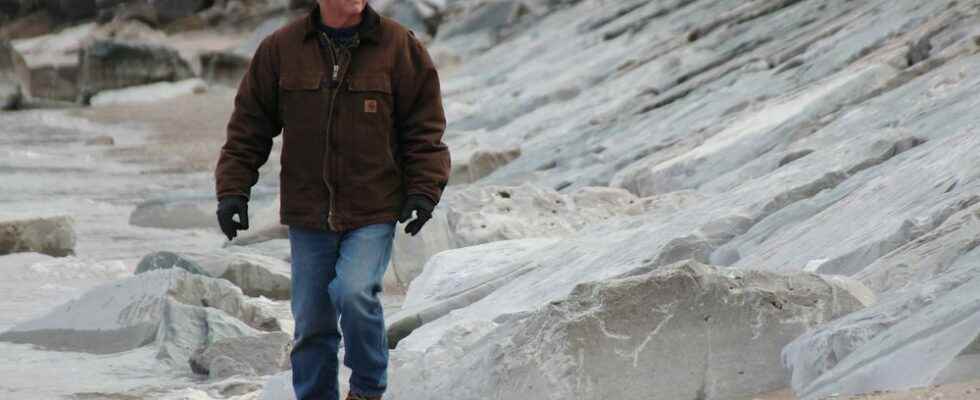Al Jones says he worries about pieces of rock coming loose along a section of Bright’s Grove shoreline revetment.
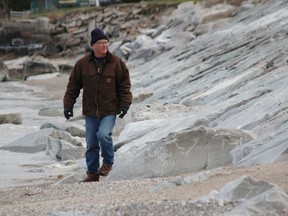
Al Jones says he worries about pieces of rock coming loose along a section of the Bright’s Grove shoreline revetment.
It’s happened already.
There are cracks cutting through some of the limestone blocks city officials said contractors finished installing for about $3 million in the summer of 2020.
In some places, chunks of armor stones have broken away and fallen partway down the revetment.
“The first thing is the safety,” Jones said, for people walking on the several-tonnes-heavy stones or on the beach below.
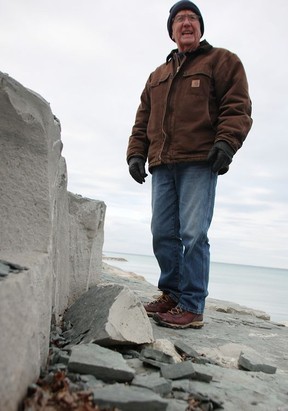
The man who said he’s lived in Bright’s Grove since 1993 also has concerns about the stones themselves shifting loose, weakening that shoreline protection.
“It appears there’s a problem,” he said, referencing protruding corners of stones in the sand and water at the revetment’s bottom.
Jones said he thinks those stones have moved as a result of heavy waves battering the break wall.
He’s already been in contact with City of Sarnia officials, he said.
Engineering and operations general manager David Jackson said there was a level of urgency two-and-a-half years ago when the section of rock wall was built to the east of Lakeshore Community Church.
Previous shoreline protection measures had failed after decades and erosion threatened the shoreline.
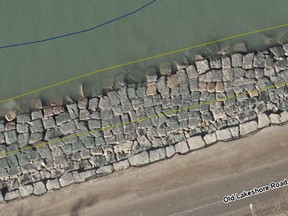
“Part of it, why (the rocks) all aren’t in a perfectly straight line all at the bottom, is because of that challenge of having to work under the high water table,” Jackson said.
“The shoreline was eroding, so we had to do it at the time. We didn’t have the luxury of waiting for the water levels to drop.”
He’s “pretty confident” stones that appear out of place at the water’s edge “would just have been the rough placement that happened due to the high-water levels,” he said.
Consultants and officials with the federal government, the city and the St. Clair Region Conservation Authority, which is helping fund 40 per cent of shoreline protection projects in Sarnia with grant Disaster Mitigation and Adaptation Fund money from the federal government, have all inspected the site multiple times, Jackson said.
“We don’t see evidence of broad, significant movement across all of the work that’s been done,” he said.
Nothing is guaranteed, and a large storm could conceivably cause damage at any time, he added, “but, in general, we don’t have a major concern right now.”
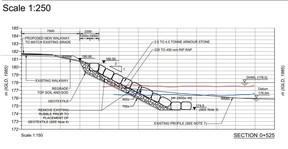
Rocks were occasionally drop tested as they were installed to check their integrity, and there were no concerns, Jackson said.
“Some pieces will break off over time, but we don’t believe there’s a broad concern with the overall quality of the rock used.”
Rock was also “challenging” to get at the time because of the high water levels and other municipalities working on shoreline protection, so the material the city ended up getting had a layer of shale on it, he said.
“As we went through the project, we started removing the blue layer and making sure the quarry was not sending them with the blue layer,” construction manager Rob Williams said.
The sediment that remained on some rocks has started to flake and crumble.
It was expected to over time, Jackson said.
But the rock from near Orillia is “generally some of the higher quality limestone armor stone that we get,” Williams said.
Since they’re natural material, some stones will be stronger than others, Jackson noted.
Shoreline protection work ongoing
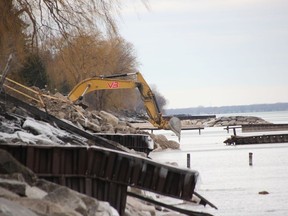
Sarnia committed to broad, long-term shoreline spending in early 2020 to prevent erosion, committing at least $2 million per year over 10 years.
That sum was bumped up already in 2020 and 2021, but it’s eased back to $2 million for 2023 in the city’s draft capital budget.
“Typical pressure on the budget,” Jackson said.
Future plans include more revetment between Penhuron Drive and Kenwick Street, he said.
Steel groynes are also a possibility to replace older, decayed versions of the beach-building structures that jut into the water.
A $900,000 Van Bree contract for a stone groyne at the end of Penhuron started earlier this week and is expected to finish in the spring, he said.
“We haven’t done groynes for a number of years so we’re excited to get back into that.”
Inflation has affected the cost of the stone groynes, said Williams, who last january estimated the cost per stone groyne at around $250,000.
“They’re desirable but they’re very expensive,” he said. “We’re trying to come up with a strategy where we can maybe alternate between stone and steel.”
A gradual groyne replacement strategy was eyed by the city in 2020 to replace the 50 or so 1970s-era decayed steel structures that the city owns.
Work in 2023 on revetment and potential steel groynes is expected to start some time after July 15 when in-water work restrictions ease, which also provides time for designs to be finalized and a permitting process.
Groynes have had to take a back seat to revetment in recent years because of the threat of erosion, Jackson said.
Now, with some of the worst areas fixed and water levels dropping again, “we feel we can comfortably focus on the groynes at the same time to expand that aspect of the shoreline work,” he said.
